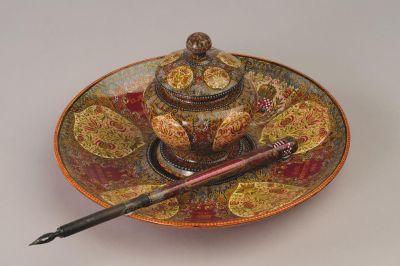
Writing set - for the ceremonial inauguration of the building of the Museum of Applied Arts
| Accession Nr.: | 1378.a-d |
|---|---|
| Manufacturer: | Zsolnay factory (Pécs) |
| Place of production: | Pécs |
| Inscription: | gyári jegy: öt templomtorony két oladalán ZSOLNAY PÉCS, ill. 1896 T. J. M. felirat |
|---|---|
| Materials: | porcelain-faience |
| Techniques: | cast; handpainted with eosin glazes |
| Dimensions: |
height: 9,5 cm
base diameter: 6,1 cm
height: 3,2 cm
base diameter: 13 cm
|
In a letter of 21 October 1896 (MAA Archive doc. no. 1896/266), Vilmos Zsolnay wrote that he had donated to the museum an inkwell and pen… for the opening ceremony of the national museum and school of applied arts. It was with this pen that King Francis Joseph I signed the completion document on 25 October 1896, during the ceremonies for the thousandth anniversary of the Hungarian Conquest (MAA Archive 591). The writing set is a unique item. The forms were designed in 1880 and 1887, but the special painted decorations were not even entered into the company’s Decor Book. The relief light fields are filled with standard motifs of the national decorative style (pomegranate, tulip) among little flowers and geometric border decorations, harmonised with the exterior (Zsolnay) ceramic tiles and internal colour scheme of the building designed by Odon Lechner (1845–1914). On the base plate is the central coat of arms of Hungary, four red shields with the legends 896 MILLENNIUM 1896, 183 ELJEN A KIRALY (Long Live the King), 1896 OKTOBER 25., and the company markings ZS five church-tower image T.J.M. 1863. The legend on the penholder is: ELJEN A KIRALY. The minutely-detailed painting on what Zsolnay also intended “to display the latest developments in ceramic technique” exemplifies the “Millennium technique”. The metal-lustre glaze fired in a reducing atmosphere to achieve reflective ruby colours was developed by Professor Vince Wartha (1844–1914) in collaboration with Vilmos Zsolnay (1828–1900). The set was also used by the King at the opening of the Museum of Fine Arts in 1906 and that of the National György Ráth Museum in 1907.
Literature
- Szerk.: Horváth Hilda, Szilágyi András: Remekművek az Iparművészeti Múzeum gyűjteményéből. (Kézirat). Iparművészeti Múzeum, Budapest, 2010. - Nr. 112. (Csenkey Éva)
- Szerk.: Pataki Judit: Az idő sodrában. Az Iparművészeti Múzeum gyűjteményeinek története. Iparművészeti Múzeum, Budapest, 2006. - Nr. 34. (Csenkey Éva)
- Szerk.: Csenkey Éva, Steinert Ágota: Hungarian Ceramics from the Zsolnay Manufactury, 1853-2001. Yale University Press, New Haven és London, 2002. - Nr. 57.A-D.
- szerző: Dr. Horváth Hilda: Iparművészeti kincsek Magyarországon. Athenaeum Kiadó, Budapest, 2000. - Nr. 50
- Szerk.: Lovag Zsuzsa: Az Iparművészeti Múzeum. (kézirat). Iparművészeti Múzeum, Budapest, 1994. - Nr. 184.
- a kiállítást rendezte: Batári Ferenc, Vadászi Erzsébet: Historizmus és eklektika. Az európai iparművészet stíluskorszakai. Iparművészeti Múzeum, Budapest, 1992. - Nr. 264. (Csenkey Éva)
- Csenkey Éva: A magyar szecesszió kerámiaművészete. Iparművészeti Múzeum, Budapest, 1985. - Nr. 22.

